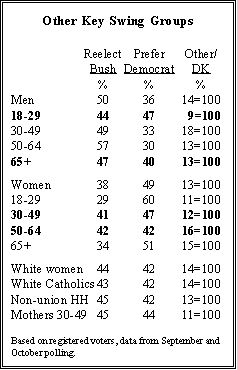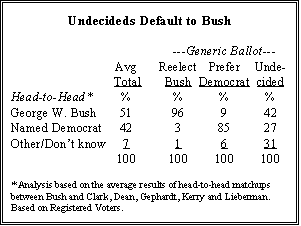 Despite GOP gains in party identification after Sept. 11, the electorate is evenly split over President Bush’s reelection. A year before the election, the divided electorate looks strikingly similar to the one reflected in exit polls from the 2000 election. Now, as then, Bush draws very strong support from men, whites, and those who regularly attend religious services. An unnamed Democratic candidate runs strongly among women, minorities, and those in the lowest income categories, as Al Gore did in 2000.
Despite GOP gains in party identification after Sept. 11, the electorate is evenly split over President Bush’s reelection. A year before the election, the divided electorate looks strikingly similar to the one reflected in exit polls from the 2000 election. Now, as then, Bush draws very strong support from men, whites, and those who regularly attend religious services. An unnamed Democratic candidate runs strongly among women, minorities, and those in the lowest income categories, as Al Gore did in 2000.
The gender gap is virtually the same as it was in 2000, as is the sharp division in candidate preference along racial and ethnic lines. There are no signs that President Bush has succeeded in winning over a significant number of minority voters, but he continues to hold a clear lead among whites.
Bush has lost significant support among young voters, while maintaining a slight edge among those age 30 and older. In the Voter News Service exit polls from 2000, voters age 18-29 were divided almost evenly between Bush and Gore. Today, this age group leans Democratic by roughly three-to-two (60%-40%).
Income continues to be a decisive factor in presidential politics. The president has made modest gains among voters in middle and upper-middle income categories, but has lost support among poorer voters. In both 2000 and the current surveys, Democrats do best among the most and least educated groups (those with a post-graduate education and those who did not finish high school), while Bush holds slim margins among those in the middle.
And religious observance continues to be a stark dividing line with respect to voting intentions. Voters who attend religious services regularly favor reelecting Bush by strong margins, while those who rarely attend religious services clearly favor a Democratic candidate.
Swing Groups Look Familiar
A year ahead of Election Day, a number of key swing groups are likely to be critical, and many of them are the same groups that candidates and analysts identified in the 2000 election. For example, while voters in the Northeast lean Democratic and voters in the South favor reelecting Bush, voters in the Midwest and West are currently evenly divided in their preference. Similarly, while urban and rural voters have a decided preference (the former leaning Democratic, the latter for Bush), voters in the suburbs and in smaller cities are split.
 And religion continues to be a critical factor among white voters. In particular, white non-Hispanic Catholics are almost evenly divided in their candidate preference today, with 43% favoring a Bush reelection, and 42% preferring a Democrat. This is virtually identical to polls conducted prior to the 2000 election. By comparison, white Protestants favor Bush by relatively large margins, while white seculars lean decidedly Democratic.
And religion continues to be a critical factor among white voters. In particular, white non-Hispanic Catholics are almost evenly divided in their candidate preference today, with 43% favoring a Bush reelection, and 42% preferring a Democrat. This is virtually identical to polls conducted prior to the 2000 election. By comparison, white Protestants favor Bush by relatively large margins, while white seculars lean decidedly Democratic.
The gender gap in presidential politics remains as formidable as in 2000. Currently, men favor reelecting Bush by a 50% to 36% margin, while women prefer the Democrat by 49% to 38%. When race is taken into account, white women emerge as a key swing group, evenly divided with 44% favoring Bush and 42% a Democrat. White men, by comparison, favor Bush by 56% to 31%.
Voters age 18-29 and those age 65 and older favor a Democratic victory in 2004, while those 30-64 tend to favor Bush’s reelection. This pattern holds among both men and women, with the result that young and older men are fairly divided in their support, while middle-aged men favor Bush by very large margins.
 Among women, the young and old overwhelmingly favor replacing Bush, while those age 30-64 are split almost evenly.
Among women, the young and old overwhelmingly favor replacing Bush, while those age 30-64 are split almost evenly.
Parents with children at home are also much more favorably disposed to reelecting the president. Looking only at people between the ages of 30 and 49 two-thirds of whom have children living at home fathers favor Bush by two-to-one while men without kids at home split their vote almost evenly. Among women age 30-49, mothers are evenly divided at this point in the race, while those without children at home favor a Democrat.
‘Generic’ vs. ‘Real’ Democrats
Voters are evenly divided between Bush and a generic Democrat, but the president retains a significant lead over all of the actual candidates for the Democratic nomination. (See p.5 for further analysis.) The gap between support for a generic Democratic candidate and support for actual candidates reflects a lack of familiarity with many of the Democrats as much as a lack of appeal on their part. A good portion of the advantage Bush has in the individual match-ups comes from voters who expressed no preference between the president’s reelection and a Democratic victory.
Of the voters who were undecided on the generic ballot (16% of all registered voters), roughly four-in-ten (42%) say they would favor Bush when his name is placed against the current Democratic candidates, while just 27% favor one of the Democrats. There are no significant differences in the appeal of the five leading candidates Ret. Gen. Wesley Clark, former Vermont Gov. Howard Dean, Gephardt, Kerry and Lieberman among these voters.
 But there also is some evidence that the Democratic candidates have failed to tap into the latent opposition to the president that does exist. Some voters who oppose a second term for the president have yet to commit to anyone in the current field of Democratic candidates. On average, the current leading candidates for the Democratic nomination lose the support of 15% of voters who favor a Democratic victory in 2004.
But there also is some evidence that the Democratic candidates have failed to tap into the latent opposition to the president that does exist. Some voters who oppose a second term for the president have yet to commit to anyone in the current field of Democratic candidates. On average, the current leading candidates for the Democratic nomination lose the support of 15% of voters who favor a Democratic victory in 2004.
At this point in the race, virtually no Bush supporters on the generic ballot defect to any specific Democratic candidate when their names are mentioned. On average, fully 96% of voters who favor Bush’s reelection stick to this position when Bush is tested against individual Democrats.


